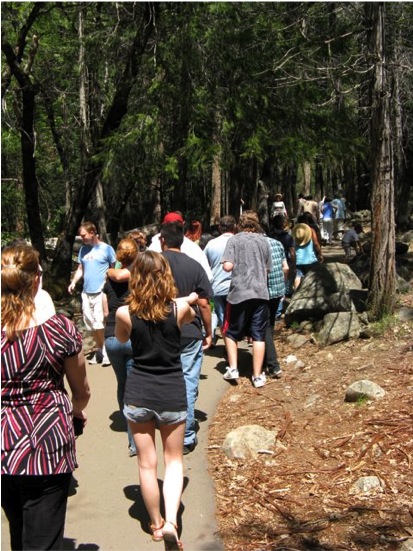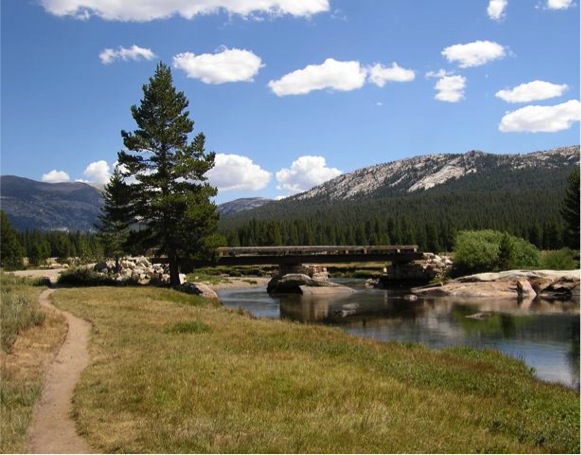The Merced Wild and Scenic River plan disappoints; in contrast, the Tuolumne River plan will visibly benefit Tuolumne Meadows
After a decade of intensive CSERC involvement in the Merced Wild and Scenic River Plan, our staff was highly frustrated when Park leaders chose to keep the status quo instead of complying with key requirements of the Wild and Scenic Rivers Act. CSERC had urged Park officials to pull at least some of the non-essential commercial facilities out of the river corridor — as the Act requires. We also pressed for strict user capacity limits to reduce crowding and congestion in Yosemite Valley and in the river corridor. Instead, the approved Merced River Plan keeps the same level of crowding and congestion of recent years. Park officials hope that more parking spaces and better traffic management will at least solve traffic congestion. But adding more parking spaces, more campsites, and more permanent overnight lodging simply increases the number of people at one time who all crowd into the eastern portion of Yosemite Valley during the peak summer season. The Park missed a key chance to protect stressed resources.
Instead, the approved Merced River Plan keeps the same level of crowding and congestion of recent years. Park officials hope that more parking spaces and better traffic management will at least solve traffic congestion. But adding more parking spaces, more campsites, and more permanent overnight lodging simply increases the number of people at one time who all crowd into the eastern portion of Yosemite Valley during the peak summer season. The Park missed a key chance to protect stressed resources.
In contrast to the strong political pressure that influenced the Merced River Plan in Yosemite Valley, Park planners faced less political pressure for the Tuolumne Wild and Scenic River Plan that included highly popular Tuolumne Meadows. Even in that plan, however, Park officials chose to keep the status quo level of visitor use rather than take actions to disperse visitation out along the Tioga Pass corridor. But despite keeping high levels of use, the Tuolumne River plan approves a number of positive environmental benefits. The most visible change will be to remove parking from the edge of the meadows along the Highway, and instead shift parking to new strategically placed parking areas. Because CSERC was able to point to very clear language in the Park’s General Management Plan, we helped convince the Park to agree to move 21 campsites that crowd into the river floodplain and prevent wildlife from moving along the River. CSERC also got the Park to tentatively approve relocating the Tuolumne Lodge. Its current location so close to the River is a direct conflict with the Wild and Scenic Rivers Act. Other changes include removing day use commercial trail rides and reducing pack stock supply trips to the Glen Aulin High Sierra Camp. Both changes are intended to reduce trail degradation and reduce conflicts with hikers and backpackers.
Because CSERC was able to point to very clear language in the Park’s General Management Plan, we helped convince the Park to agree to move 21 campsites that crowd into the river floodplain and prevent wildlife from moving along the River. CSERC also got the Park to tentatively approve relocating the Tuolumne Lodge. Its current location so close to the River is a direct conflict with the Wild and Scenic Rivers Act. Other changes include removing day use commercial trail rides and reducing pack stock supply trips to the Glen Aulin High Sierra Camp. Both changes are intended to reduce trail degradation and reduce conflicts with hikers and backpackers.
At the County board session that was held to rescind the project approval, verbal attacks on CSERC by the supervisors continued. The building industry used CSERC’s lawsuit as a reason to launch printed attacks blaming CSERC for the woes of the industry. No one at the County acknowledged that this is the second time in three years that the supervisors failed to follow the law with a mining project. County politicians and development interests prefer to blame the situation on environmentalists – claiming CSERC and others are intent on stopping all projects. In contrast to the rhetoric, CSERC and other local conservation groups gladly met last year with a developer and gave general support to her plans for a giant new development project at the old Big Oak Flat scar site along Highway 120. But because the County and the local building industry didn’t provide enough support, the developer ended up dropping tens of millions of dollars of development plans and significantly scaled down the project. If the builders and politicians put their time into supporting appropriately located projects that follow the law instead of attacking CSERC, they might actually boost demand for new constuction. They could also avoid lawsuits.
Click to learn more details about both of Yosemite Park’s wild river plans

